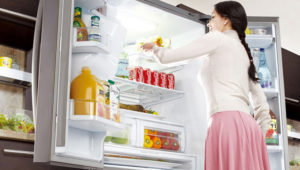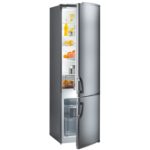 The compressor is the main device in the refrigerator, which regulates the temperature inside the product, distilling the refrigerant through a tube system. There are quite a few types of these devices, but recently a refrigerator with an inverter compressor has appeared on sale, which most users have not even heard of.
The compressor is the main device in the refrigerator, which regulates the temperature inside the product, distilling the refrigerant through a tube system. There are quite a few types of these devices, but recently a refrigerator with an inverter compressor has appeared on sale, which most users have not even heard of.
Technical progress does not stand still, and many well-known companies are already introducing such devices into production, but potential buyers are primarily interested in the essence of innovation. To understand how the new look differs from the familiar to everyone, sometimes quite rumbling unit, you need to read our article.
Content
Types of Compressors
Manufacturers for their models of refrigerators use the following compressors:
- Piston. Quite a popular species, often found in refrigeration units. It consists of one or more cylinders, which are located in a horizontal or vertical position. The working process is carried out during the reciprocating movement of the pistons, which is controlled by a crank mechanism.
- Screw or rotary. Known from the end of the 19th century, the pressure difference arises due to the rotation of the rotor and the movable plate - in other words, these are two spirals, blown into each other. During rotation, the refrigerant is quite strongly compressed and squeezed out into the pipeline. These types of compressors are installed on select Indesit models.
- Linear. The duty cycle can be divided into three stages - switching on, active cooling and switching off. Control over the optimum temperature is carried out by a sensor, which, when it increases, turns on the compressor. This cycle is maintained continuously until the product is disconnected from the mains. The movement of the piston in the cylinder is carried out due to electromagnetic forces, because of this, energy losses are reduced, and the service life is increased. This compressor is used by Electrolux.
- Invertor. It is in operation continuously without shutdown, only after reaching the optimum storage temperature of food it switches to low revolutions. For stable maintenance of the optimum mode, it uses low power, actively saving the consumption of electric energy. These devices are used by Samsung.
There are two more types of compressors, but modern household refrigerators are rarely equipped with them:
- oil-free - as a rule, they are equipped with large-scale industrial plants;
- electro-gas-dynamic products, where the desired pressure is obtained due to the formation in the electric field of space charges of particles.
All types of compressors have a designated resource, as well as a deadline for operation and require periodic maintenance. If a compressor malfunctioned in the domestic refrigerator, then the home master should not try to fix something - there are specialists from the service center for this.
What is an inverter compressor
It, in contrast to the linear one, never turns off, but smoothly switches to another mode of operation with fewer revolutions. Technically, this can be explained as follows: there is a gradual conversion of alternating current into direct current, then the reverse process occurs, but a certain speed is set.
A three-phase electric motor with a brushless system that rotates the compressor is used not only in modern household refrigerators, but also in the production of various mechanisms for the automotive industry, computer and medical equipment.
Principle of operation
When creating a new product, the developers took into account all the flaws of the linear device, the inverter compressor in the refrigerator works on almost the same principle, only with some nuances. When the optimum temperature is reached, it does not turn off, but only reduces speed and reduces the speed of movement of freon through a complex system of pipelines. Thus, it constantly maintains a cooling mode inside the unit.
When users open the door to get something out or put it down, the temperature rises, the control sensor is triggered, and the compressor immediately increases the rotation speed. The new device works smoothly and almost silently, because the minimum power is used - this means that energy consumption is saved.
Advantages and disadvantages
Inverter compressors are a new generation of devices that never stop while working in the refrigerator, but continue to rotate at low speeds, this process has its advantages and disadvantages, which we will talk about in more detail.
First, as is customary, consider the advantages of household refrigerators with innovative devices:
- Low electricity consumption, therefore, the inverter type has the highest energy saving class, because they are 20% more economical than any type of compressor. The reason is hidden in that they use maximum power only when they are first turned on.
- The inclusion is almost silent, in contrast to the linear counterpart.
- The temperature set by the user is always at the same level if the doors do not open.
- The absence of amplitude surges, which quite strongly affect the wear of mechanisms, leads to the fact that the service life of such compressors is higher than all types used in technology. Ten years of warranty from the manufacturer confirms the high quality of the product.
Modern products, like their ancestors, cannot have only positive qualities - there will always be, although insignificant, but disadvantages:
- voltage surges, which are characteristic of our electric networks, can lead to failure of the compressor, therefore it is necessary to install circuit breakers on the home panel;
- high cost discourages a potential buyer, but experts assure that it quickly pays off with high savings during operation.
To protect their models from overloads and power surges, individual companies install voltage stabilizers, which, in the event of danger, put the refrigerator into standby mode, and after normalizing the voltage, they resume standard operation.
What is different from a conventional device
The linear type is a common compressor option that has been used for many years. We have already considered the differences in the principle of operation, therefore, we skip, but recall that the inverter type operates constantly at low speeds, and the linear one turns on and off periodically, which is considered its main drawback.
Due to such inclusions, power surges in the home network and increased load occur, the energy consumption is also quite large. New compressors have minimal electricity consumption due to their low-speed operation and, accordingly, low power. In addition, the inverter type works constantly, but it is inaudible for the user, there is no usual rumbling and vibration of the case, it is more like a purring of a cat, and not the compressor.
Refrigerators with new compressors quite confidently make their way to our apartments, but not all users can afford this cost with the same quality of food preservation. Old products have been working with some consumers for 30 years or more - judging by the reviews, they are not going to retire yet.
Which is better - inverter or linear
How long to talk about the superiority of one species over another, let's look at the table where we have reduced the main parameters and differences of each species.
Comparison table
| Characteristic | Differences: Linear / Inverter |
| Resource | Service life is limited / 10 year warranty |
| Power on when turned on | Maximum at each on / only at startup |
| Network load | Frequent power surges / no problem |
| Noise level | Relay clicks, compressor operation / almost silent |
| Adjustment | Identical in temperature |
| Wear parts | Large / small |
To understand exactly which compressor works, you can compare them with the movement of the car: in the first case, there are bumps and alternating ups and downs, and the second is a freeway with perfectly even coverage and slight curvature by turns.
Rating
Samsung RB-30 J3200SS
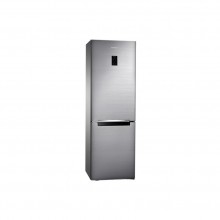
- Dimensions: 595x668x178 mm.
- Energy saving class: A + (272 kWh / year).
- Total volume: 311 liters.
- Freezer: 98 l.
- Fridge: 213 liters.
- Climate class: N, SN, ST.
- Power freezing: 12 kg / day.
- Standalone cold preservation: 20 hours
- Defrost system: No Frost.
- Type of compressor: inverter.
- Noise level: to 39 dB.
- Weight: 66.5 kg.
- stylish appearance
- outdoor display
- spacious
- glass shelves
- high build quality and all materials
- not identified
Liebherr CN 4015
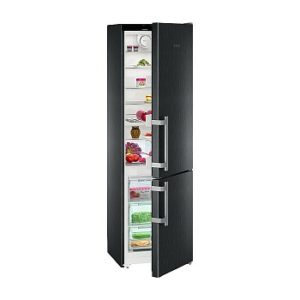
- Dimensions: 600x625x201.1 mm.
- Energy saving class: A ++ (229 kWh / year).
- Total volume: 356 liters.
- Freezer: 87 l.
- Refrigerator: 269 l.
- Climate class: SN, T.
- Power freezing: 11 kg / day to -24 degrees.
- Standalone cold preservation: 18 hours
- Defrost system:
The refrigerator is drip.
Freezer - No Frost. - Sound pressure: 39 dB.
- Weight: 76.5 kg.
- internal display
- door closing indicator
- shelf height adjustment
- vacation mode
- antibacterial protection
- child protection
- not identified
LG GA-E429 SQRZ
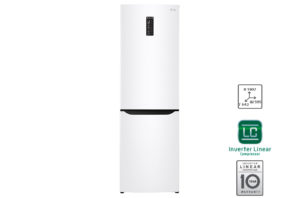
- Dimensions: 594x643x190.7 mm.
- Energy saving class: A ++ (221 kWh / year).
- Total volume: 302 liters.
- Freezer: 79 l.
- Refrigerator: 223 l.
- Climate class: N, SN, ST.
- Compressor: linear inverter.
- Defrost system: Total No Frost.
- Noise Level: 39 dB.
- Weight: 70 kg.
- super freezing
- Wi-Fi, Smart Diagnostics
- touchscreen
- door seal Bio Shield
- wine bottle shelf
- some users complain of compressor noise.
LG GW-B499 SQGZ

- Dimensions: 595x665x201 mm.
- Energy saving class: A ++ (266 kWh / year).
- Total volume: 343 liters.
- Freezer: 223 L
- Fridge: 93 l.
- Zero chamber: 27 liters
- Climate class: N, SN, ST and T.
- Power freezing: 9 kg / day.
- Standalone cold preservation: 16 hours
- Defrost system: No Frost.
- Type of compressor: inverter linear type.
- Sound pressure: 37 dB.
- Weight: 82 kg.
- excellent ratio of shelves and drawers
- separate freshness zone NatureFRESH
- nice design
- high quality materials
- not identified
Samsung RB-30 J3200EF
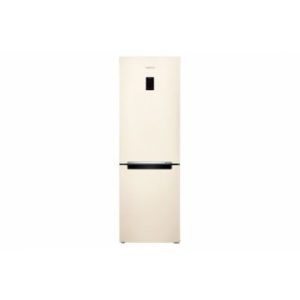
- Dimensions: 595x668x178 mm.
- Energy saving class: A + (272 kWh / year).
- Total volume: 311 liters.
- Freezer: 98 l.
- Fridge: 213 liters.
- Climate class: SN, ST.
- Power freezing: 12 kg / day.
- Standalone cold preservation: 20 hours
- Defrost system: No Frost.
- Type of compressor: inverter.
- Noise Level: 39 dB.
- Weight: 66.7 kg.
- perfect value for money
- strict, concise appearance
- quiet quality work
- abundance of containers for freezing
- does not require defrosting
- easy to wash glass shelves
- not identified
findings
The refrigerator is the second household appliance after the stove in the kitchen space, it allows you to keep food fresh, and modern models guarantee the preservation of all vitamins in vegetables and fruits, regardless of their shelf life within reasonable limits.
The times have gone into oblivion when old refrigerators woke us with the loud operation of the compressor, especially when it was turned on. Today, cats love their place to sleep at the top of the two-chamber giant, and yet they are very sensitive to vibration and noise.
 |  | 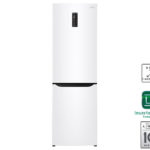 |  | 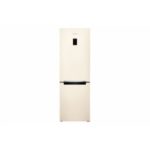 |
|
| Title | Samsung RB-30 J3200SS | Liebherr CN 4015 | LG GA-E429 SQRZ | LG GW-B499 SQGZ | Samsung RB-30 J3200EF |
| Control | electronic | electronic | electronic | electronic | electronic |
| Energy consumption | class A + (272 kWh / year) | class A ++ (229 kWh / year) | class A ++ (221 kWh / year) | class A ++ (266 kWh / year) | class A + (272 kWh / year) |
| Dimensions (WxDxH) | 59.5x66.8x178 cm | 60x62.5x201.1 cm | 59.5x64.3x190.7 cm | 59.5x66.5x201 cm | 59.5x66.8x178 cm |
| Ice maker | absent | absent | absent | absent | absent |
| Noise level | up to 39 dB | up to 39 dB | up to 39 dB | up to 37 dB | up to 39 dB |
| Price | from 29 100 rub. | from 45000 rub. | from 34 350 rub. | from 53150 rub. | from 28850 rub. |
